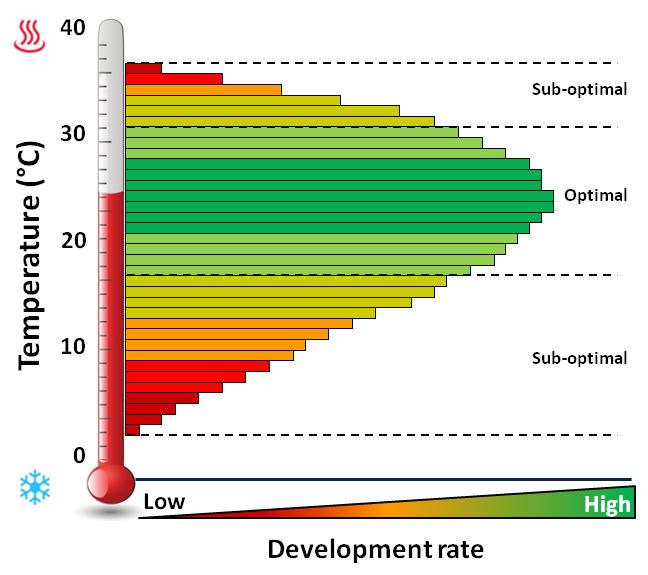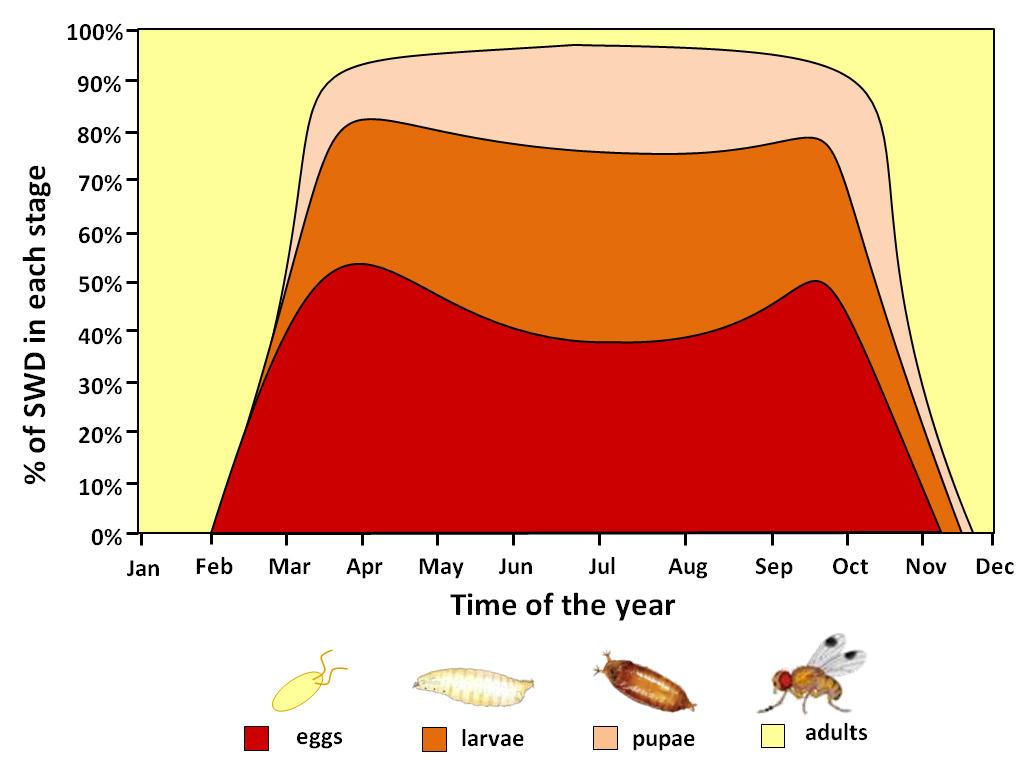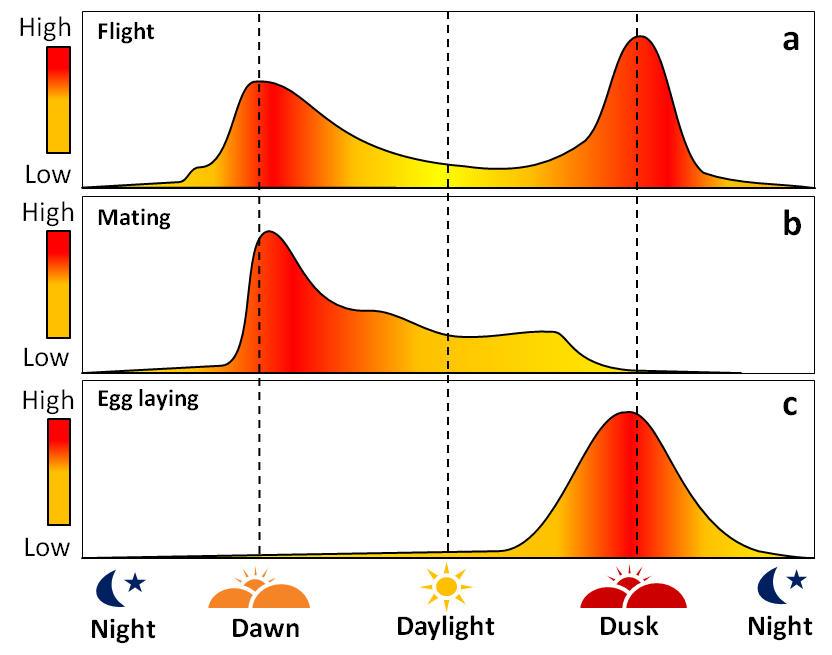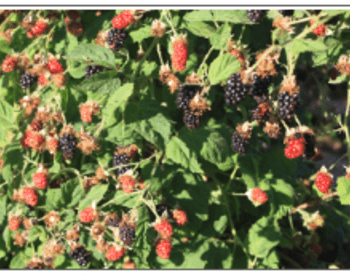SWD series #1
Key points in this fact sheet
- Spotted-wing drosophila (SWD) are less active during cold winter months, and mostly survive as adult females during this period.
- SWD exist as adult In two morphs or body types. In cold-winter climates, SWD adults can assume a larger, darker-colored winter morph or body type..
- When temperatures rise above 50°F (10°C) for more than five consecutive days, populations can increase.
- When mean daily temperatures are below 50°F (10°C) or above 82°F (28°C), SWD become less active and reproduce more slowly.
- As the growing season progresses, generations overlap, resulting in a relatively stable distribution among different life stages.
- There is a stable population structure during the growing season. During this time, populations consist largely of immature life stages that are protected inside fruit.
- During the growing season, the population structure consists of 90% eggs, larvae or pupae and 10% adults.
- During hot summer periods, most activity, including egg laying, occurs during dusk and dawn.
Seasonal population structure and reproduction
Most spotted-wing drosophila (SWD) that survive the winter do so as adult females. Winter morph females mate during fall, store the sperm over winter, and infest the first ripening fruits in early spring. As temperatures fall below 50°F (10°C), few SWD females carry eggs and the population decreases. When temperatures rise above 50°F (10°C) for periods longer than five days, the fertilized eggs within SWD females start to mature and the population begins to increase above the overwintering level (see Figure 1, page 2).
When temperatures reach 64°F (18°C), adult females lay more eggs (Figures 1 and 2, page 2). Eggs hatch into larvae, which develop into pupae and then adults at increased rates as temperatures climb during the summer. As the season progresses, it is possible for the generations to overlap, resulting in a relatively stable distribution among different life stages (egg, larva, pupa, adult). In Oregon, approximately 90% of all life stages are eggs, larvae and pupae during this period, with only 10% in the adult life stage (Figure 3, page 2).
One reason SWD is so difficult to manage is that eggs, larvae and pupae are well protected within the fruit or in the soil. Also, a steady stream of adults reaches reproductive maturity and attacks the crop. When average daily temperatures drop below 50°F (10°C) or increase above 82°F (28°C), SWD become less active and reproduce at lower rates. However, the insect can optimize its behavior to daily temperature cycles. During hot summer periods, the majority of activity, including egg-laying, occurs during the cooler dusk and dawn periods (Figure 4).
Further reading
Dalton, D.T., V.M. Walton, P.W. Shearer, D.B. Walsh, J. Caprile, R. Isaacs. 2011. Laboratory survival of Drosophila suzukii under simulated winter conditions of the Pacific Northwest and seasonal field trapping in five primary regions of small and stone fruit production in the United States. Pest Management Science 67:368–1374. https://doi.org/10.1002/ps.2280
Emiljanowicz, L.M., G.D. Ryan, A. Langille, J. Newman. 2014. Development, reproductive output and population growth of the fruit fly pest Drosophila suzukii (Diptera: Drosophilidae) on artificial diet. Journal of Economic Entomology 107(4):1392–1398. https://doi.org/10.1603/ec13504
Grassi, A., A. Gottardello, D.T. Dalton, G. Tait, D. Rendon, C. Ioriatti, D. Gibeaut, R. Stacconi, M. Valerio, V.M. Walton. 2018. Seasonal Reproductive Biology of Drosophila suzukii (Diptera: Drosophilidae) in Temperate Climates. Environmental Entomology 47, 166–174. https://doi.org/10.1093/ee/nvx195
Hamby, K.A., D.E. Bellamy, J.C. Chiu, J.C. Lee, V.M. Walton, N.G. Wiman, R.M. York, A. Biondi. 2016. Biotic and abiotic factors impacting development, behavior, phenology, and reproductive biology of Drosophila suzukii. Journal of Pest Science 89(3): 605–619. https://doi.org/10.1007/s10340-016-0756-5
Tochen, S., D.T. Dalton, N. Wiman, C. Hamm, P.W. Shearer, V.M. Walton. 2014. Temperature-related development and population parameters for Drosophila suzukii (Diptera: Drosophilidae) on cherry and blueberry. Environmental Entomology 43(2):501–510. https://doi.org/10.1603/EN13200
Wiman, N.G., V.M. Walton, D.T. Dalton, G. Anfora, H.J. Burrack, J.C. Chiu, K.M. Daane, A. Grassi, C. Ioriatti, B. Miller, S. Tochen, X. Wang, C. Ioriatti. 2014. Integrating temperature-dependent life table data into a matrix projection model for Drosophila suzukii population estimation. PLoS One 9(9): e106909. https://doi.org/10.1371/journal.pone.0106909
Rendon D., V.M. Walton, G. Tait, J. Buser, I. Lemos Souza, A.K. Wallingford, G. Loeb, J.C. Lee. 2019. Interactions among morphotype, nutrition, and temperature impact fitness of an invasive fly. Ecology and Evolution 9: 2615-2628. DOI: 10.1002/ece3.4928
Rendon, D., J. Buser, G. Tait, J.C. Lee, V.M. Walton. 2018. Survival and fecundity parameters of two Drosophila suzukii morphs on variable diet under suboptimal temperatures. Journal of Insect Science 18(6): 1-7.
Rendon, D., K. Hamby, A. Arsenault-Benoit, C.M. Taylor, R.K. Evans, C.R. Roubos, A.A. Sial, M. Rogers, A. Petran, S. Van Timmeren, P. Fanning, R. Isaacs, V.W. Walton. 2019. Mulching as a cultural control strategy for Drosophila suzukii in blueberry. Pest Management Science. DOI: 10.1002/ps.5512
Stockton, D., A.K. Wallingford, D. Rendon, P. Fanning, C.K. Green, L. Diepenbrock, E. Ballman, V.M. Walton, R. Isaacs, H. Leach, A.A. Sial, F. Drummond, H. Burrack, G.M. Loeb. 2019. Interactions between biotic and abiotic factors affect survival in overwintering Drosophila suzukii (Diptera: Drosophilidae). Environmental Entomology 48: 454–464.
About this series
This publication is one of a series of nine publications focused on strategies for controlling spotted-wing drosophila in Oregon. Find them at https://catalog.extension.oregonstate.edu/. The publications in this series include:
- EM 9261: How Seasons Affect Population Structure, Behavior and Risk on Spotted-wing Drosophila
- EM 9262: Cultural Control Strategies to Manage Spotted-wing Drosophila
- EM 9263: Host Range and Characteristics Affecting Fruit Susceptibility to Spotted-wing Drosophila
- EM 9264 Noncrop Host Plants Used By Spotted-wing Drosophila
- EM 9265: Chemical Control of Spotted-wing Drosophila: Spray Applications
- EM 9266: Chemical Control of Spotted-wing Drosophila: Insecticide Efficacy
- EM 9267: Monitoring Techniques for Spotted-wing Drosophila
- EM 9268: Potential Impacts of Irrigation on Biocontrol on Spotted-wing Drosophila Populations
- EM 9269: Biocontrol of Spotted-wing Drosophila
© 2019 Oregon State University.









